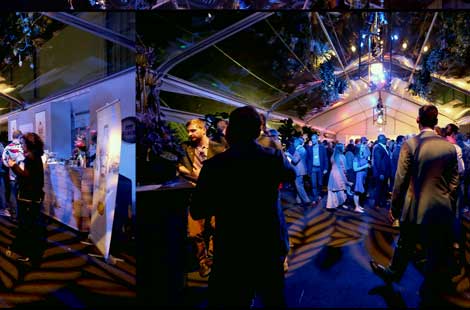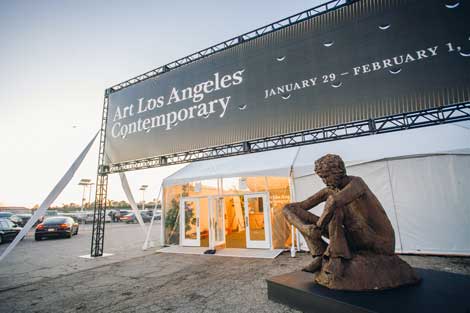GALLERY MOVES
In and Out, Back and Forth
Two of our longtime Los Angeles galleries are closing: Angles Gallery is shutting down its La Cienega space, and Frank Lloyd has vacated Bergamot Station with its final show—of two legendary figures in postwar LA art, Peter Voulkos and Craig Kauffman, which closed Feb. 14. Meanwhile, Edward Cella Art + Architecture and Rosamund Felsen Gallery are soon relocating, the former into the Angles space in the Culver City Arts District.
Angles was founded 30 years ago by David McAuliffe and was, as their website says, “committed to contemporary art that emphasizes conceptual work by established as well as emerging artists.” For the last 19 years Lloyd has featured some of the best artists in this city, including the likes of Larry Bell, John Mason and Adrian Saxe—many of whom pioneered ceramics as fine art. “When I started the gallery,” he says on his blog, “I had a specific mission of presenting ceramic artwork in a fine-art context. The gallery functioned on three levels: as a commercial venue for individual artists, as an educational resource for the community of Southern California (I wanted to preserve a legacy of ceramics in Los Angeles). Finally, the gallery served as a forum for dialogue among artists, collectors and critics.” His artist stable has come to encompass those from Europe, Mexico and Japan. He says it’s time to move on—and also mentions the need to take care of an elderly mother. Lloyd will continue his business through a private office in Pasadena.
Edward Cella has signed for the former Angles space at 2754 S. La Cienega (next door to Western Project) which previously was the Blum & Poe space—the gallery that started the Culver City gallery boom. After some remodeling, Cella will open his new quarters in May. This means a 50% expansion for the gallery—to 3,000 square feet—and a smooth transition from its current LACMA-adjacent Wilshire location, which Cella needs to leave due to upcoming Metro construction. Felsen will be setting up downtown at 1923 S. Santa Fe—also CB1 Gallery’s new venue, and will move in after renovation, keeping her Bergamot Station gallery active until then. And then there’s our burgeoning new downtown arts area. With Wilding Cran, CES and MAMA galleries already in place, the area around downtown Los Angeles is culturally hopping.
JANUARY IS LA FAIR MONTH
Four venues have lots to look at, and buy
In Los Angeles, art fairs have become weekend sport in January—men, women, children and even a few well-behaved pets all go to see what’s new, what’s entertaining and what may turn our eyeballs around a bit. There was plenty of art to choose from, in many varieties, forms, and price points, at the four art fairs—the Los Angeles Art Show, Photo LA, Art Los Angeles Contemporary (ALAC) and Paramount Ranch 2. Yes, Yours Truly managed to visit all four, and on the second weekend blew a car tire and came down with the flu. Was it overexposure to the hoi polloi, or seeing too much too soon? Not sure.
The biggest of them all was the L.A. Art Show (Jan. 14–18), which celebrated its 20th anniversary this year. It boasted 200,000 square feet of space at the Convention Center and an attendance of 60,000—a rise of 10,000 over last year. The opening has become something of a feeding frenzy, literally, as visitors thronged the food stalls in the back. They quickly ran out of complimentary food and even water. A week later, on the other side of town in Barker Hangar, the opening of ALAC (Jan. 29–Feb. 1) was also mobbed. Director Tim Fleming said they hit record attendance, although his organization did not reply with specific numbers when requested.
The variety of work shown at the L.A. Art Show can be exciting or it can be off-putting, depending on your tastes and energy level. The “Littletopia” section focusing on smaller, younger galleries and emerging artists continues to be one of the most popular. People were awestruck by the remarkably lifelike sculpture made by Kazuhiro Tsuji at Copro Gallery—one depicts the head of Salvador Dali, the other of Andy Warhol. These hyper-realistic, larger-than-life-size busts were meticulously made by the former Hollywood makeup artist, replete with hair placed strand by strand, skin pores and shiny glass eyeballs. Red Truck Gallery of New Orleans always brings some wonderful retro/Goth artists. This time I was entranced by the paintings and prints of Evan B. Harris. His work has the look of antique prints, but with haunting, Surrealistic narratives about mermaids and sailors and circuses.
On another spectrum were high-end contemporary works at such LA galleries as Jack Rutberg and Timothy Yarger, antique prints at Arader Gallery and master drawings and paintings at M. S. Rau Antiques of New Orleans. At Rau were the likes of Vincent Van Gogh, Claude Monet, Berthe Morisot and Rosa Bonheur, whose painting The Horse Fair was a real highlight. Bonheur was a 19th-century artist known for her muscular portrayals of horses and handlers and for managing to make an art career at a time when women generally had no status outside the home. The painting was quite large—4’ high and 8’ wide— and action-packed as men try to restrain a potential stampede of rambunctious steeds. Two other, larger versions of this subject matter by Bonheur hang at the Met in New York and at the National Gallery in London— originally a gift to Queen Victoria, an admirer of Bonheur. While one contemporary gallerist bemoaned to me a lack of sales at the fair, William Rau reported some strong ones, including a Monet fragment to a U.S. collector for slightly under a million and a Renoir to a South American collector for slightly over a million.
That same weekend, Photo LA (Jan. 15–18) was also brimming with visitors. There were grumblings when the fair first moved to The Reef/LA Mart, located in an iffy area south of downtown, but it looks like photo enthusiasts have comfortably relocated. The new spurt in the growth of the “Art District” nearby probably helps geographic recognition. Monroe Gallery of Sante Fe had a good position up near the entrance, and its exhibition of black-and-white photography from the Civil Rights Movement, “Selma: 50 Years,” was very timely, 2015 being the semi-centennial of the Selma-to-Montgomery marches and the resulting passage of the Voting Rights Act. At Monroe’s booth there was a photo of the charismatic Martin Luther King leading a march, arms linked with other activists; there was a close-up of Rosa Parks in Montgomery in 1965—in 1955, her arrest for refusing to give up her seat on a bus lit the spark for the Civil Rights Movement.
The Blind Photographer’s Guild featured the works of Bruce Hall, who though legally blind has some limited sight. Cameras actually help him to see, and he has been photographing his twin sons, both autistic, for a decade. It’s a remarkable series, with some close-ups, some blurry action shots of the boys playing in the yard or swimming pool.
Photo LA is to be commended for continuing a strong programming component, both in seminars and in special exhibitions such as “Point of View”— featuring selections from 24 LA-based collectors (Yours Truly here wrote the wall captions for that one)—and “Off the Clock,” the APA LA’s annual curated show, this year composed of 100 images selected by guest curator Britt Salvesen, LACMA’s head of photography.
On the second weekend, I actually made it over to Agoura Hills for Paramount Ranch 2 (Jan. 31–Feb. 1). Some 50 dealers (up from 36 last year) were wedged into various buildings of what was once the Old West backlot for Paramount Pictures. Gallerists Alex Freedman and Robbie Fitzpatrick (of Freedman Fitzpatrick gallery) founded the fair along with artists Liz Craft and Pentti Monkkonen.
It was a fun place to visit, but perhaps not the best place to see art, although a surprising number of out-of-state and foreign galleries were there. Kai Matsumiya of New York showed the colorful and imaginative fantasy collage-drawings and small sculpture of Japanese artist Tai Ogawa. Oliver Sweet, Alec Regan and Britanny Ellenz (of American Fantasy Classics) built a cave into the Green Gallery (of Milwaukee) space, and visitors were invited to sit and watch videos. I didn’t see any sales while at this quirky fair, but heard that there were some, so I hope that means the fair will continue and have a chance to mature. Personally, I think it would be fab if more space were turned over to full-scale artist installations—the setting lends itself beautifully to that.


